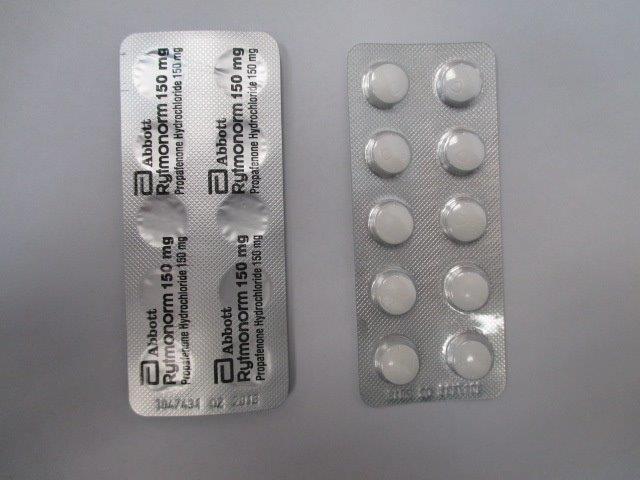Quest for the right Drug

ריתמונורם 150 מ"ג RYTMONORM 150 MG (PROPAFENONE HYDROCHLORIDE)
תרופה במרשם
תרופה בסל
נרקוטיקה
ציטוטוקסיקה
צורת מתן:
פומי : PER OS
צורת מינון:
טבליות מצופות פילם : FILM COATED TABLETS
עלון לרופא
מינוניםPosology התוויות
Indications תופעות לוואי
Adverse reactions התוויות נגד
Contraindications אינטראקציות
Interactions מינון יתר
Overdose הריון/הנקה
Pregnancy & Lactation אוכלוסיות מיוחדות
Special populations תכונות פרמקולוגיות
Pharmacological properties מידע רוקחי
Pharmaceutical particulars אזהרת שימוש
Special Warning עלון לרופא
Physicians Leaflet
Pharmacological properties : תכונות פרמקולוגיות
Pharmacodynamic Properties
5.1. Pharmacodynamic Properties Pharmacotherapeutic group: Antiarrhythmics, class IC ATC-Code: C01BC03 Propafenone is a class IC anti-arrhythmic agent. It has a stabilising action on myocardial membranes, reduces the fast inward current carried by sodium ions with a reduction in depolarisation rate and prolongs the impulse conduction time in the atrium, AV node and primarily, in the His-Purkinje system. Impulse conduction through accessory pathways, as in WPW syndrome, is either inhibited, by prolongation of the refractory period or blockade of the conduction pathway, both in anterograde but mostly retrograde direction. At the same time, spontaneous excitability is reduced by an increase of the myocardial stimulus threshold while electrical excitability of the myocardium is decreased by an increase of the ventricular fibrillation threshold. Anti-arrhythmic effects: Slowing of upstroke velocity of the action potential, decrease of excitability, homogenisation of conduction rates, suppression of ectopic automaticity, lowered myocardial disposition to fibrillation. Propafenone has moderate beta-sympatholytic activity without clinical relevance. However, the possibility exists that high daily doses (900 - 1200 mg) may trigger a sympatholytic (anti-adrenergic) effect. In the ECG, propafenone causes a slight prolongation of P, PR and QRS intervals while the QTC interval remains unaffected as a rule. In digitalised patients with an ejection fraction of 35-50%, contractility of the left ventricle is slightly decreased. In patients with acute transmural infarction and heart failure, the intravenous administration of propafenone may markedly reduce the left ventricular ejection fraction but to an essentially lesser extent in patients in the acute stages of infarction without heart failure. In both cases, pulmonary arterial pressure is minimally raised. Peripheral arterial pressure does not show any significant changes. This demonstrates that propafenone does not exert an unfavourable effect on left ventricular function which would be of clinical relevance. A clinically-relevant reduction of left ventricular function is to be expected only in patients with pre-existing poor ventricular function. Untreated heart failure might then deteriorate possibly resulting in decompensation.
Pharmacokinetic Properties
5.2. Pharmacokinetic Properties Propafenone is a racemic mixture of S- and R-propafenone. Absorption Following oral administration, propafenone is nearly completely absorbed from the gastrointestinal tract in a dose-dependent manner. Maximal plasma concentrations are reached between two to three hours following the administration of propafenone hydrochloride. After a single dose of one tablet, bioavailability is about 50%. With repeated doses, plasma concentration and bioavailability rise disproportionately due to saturation of the first pass metabolism (CYP2D6) in the liver. Although food increased the maximal plasma concentration and bioavailability in a single dose study, during multiple dose administration of propafenone to healthy subjects, food did not change bioavailability significantly. Distribution Propafenone distributes rapidly in the body. The steady-state volume of distribution is 1.9 to 3.0 L/kg. Therapeutic plasma levels are in the range of 150 ng/mL to 1500 ng/mL. The degree of plasma protein binding of propafenone is concentration dependent and decreased from 97.3% at 0.25 µg/mL to 81.3% at 100 µg/mL. In the therapeutic concentration range, more than 95% of propafenone is bound to plasma proteins. Biotransformation and elimination Comparing cumulative urinary excretion over 24 hours allowed for the calculation that 1.3% of intravenous (70 mg) and 0.65% of oral (600 mg) propafenone is excreted unchanged in the urine, i.e. propafenone is almost exclusively metabolised in the liver. The estimated propafenone elimination half-life ranges from 2 to 10 hours for extensive metabolisers and from 10 to 32 hours for poor metabolisers. A close positive correlation between plasma level and AV conduction time was seen in the majority of both healthy volunteers and patients. Clearance of propafenone is 0.67 to 0.81 L/h/kg. After a plasma level of 500 ng/ml, the PR interval is statistically significantly prolonged as compared to baseline values which allows for dose titration and monitoring of the patients with the help of ECG readings. The frequency of ventricular extrasystoles decreases as plasma concentrations increase. Adequate anti-arrhythmic activity has, in single cases, been observed at plasma levels as low as <500 ng/ml. Steady state is reached after 3 or 4 days, when bioavailability increases to about 100%. The recommended dosing regimen of propafenone is the same regardless of the metabolic status (i.e., poor or extensive metabolizers) for all patients. Elderly population Propafenone exposure in elderly subjects with normal renal function was highly variable, and not significantly different from healthy young subjects. Exposure to 5-hydroxypropafenone was similar, but exposure to propafenone glucuronides was doubled. Renal impairment Even in the presence of impaired renal function, reduced elimination of propafenone is not likely, which is confirmed by case reports and single kinetic studies in patients on chronic haemodialysis. However, accumulation of glucuronide metabolites was observed. Clinical chemistry values did not differ from those of patients with uncompromised kidneys. Propafenone hydrochloride should be administered cautiously in patients with renal disease. Liver impairment Propafenone shows an increased oral bioavailability and half-life in patients with liver impairment. The dosage must be adjusted in patients with liver disease.

שימוש לפי פנקס קופ''ח כללית 1994
Life-threatening ventricular arrhythmias such as sustained ventricular tachycardia. יירשם ע"י רופא קרדיולוג
תאריך הכללה מקורי בסל
01/01/1995
הגבלות
תרופה מוגבלת לרישום ע'י רופא מומחה או הגבלה אחרת
מידע נוסף
